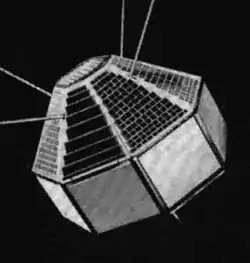Explorer 45
Explorer 45 (also called as S-Cubed A and SSS-A) was a NASA satellite launched as part of Explorers program. Explorer 45 as launched on 15 November 1971 from the San Marco platform of the Broglio Space Center, with a Scout rocket. Explorer 45 was the only one to be released from the program Small Scientific Satellite.[1][4]
 Explorer 45 (SSS-A) | |
| Mission type | Space physics |
|---|---|
| Operator | NASA |
| COSPAR ID | 1971-096A[1] |
| SATCAT no. | 5598[2] |
| Spacecraft properties | |
| Launch mass | 52 kg (115 lb) |
| Start of mission | |
| Launch date | 15 November 1971, 05:52 UTC[3] |
| Rocket | Scout B S163CR[3] |
| Launch site | San Marco platform, Broglio Space Center[3] |
| End of mission | |
| Last contact | 30 September 1974 |
| Decay date | 10 January 1992[2] |
| Orbital parameters | |
| Reference system | Geocentric |
| Regime | Highly Elliptical |
| Eccentricity | 0.66982[1] |
| Perigee altitude | 224 km (139 mi)[1] |
| Apogee altitude | 27,031 km (16,796 mi)[1] |
| Inclination | 3.5°[1] |
| Period | 469.3 minutes[1] |
| Epoch | 14 November 1971[1] |
Scientific objectives
Explorer 45 was designed to perform a wide variety of investigations within the magnetosphere with regards to particle fluxes, electric fields, and magnetic fields. Its primary scientific objectives were:
- Study the characteristics and origin of the earth's ring current and development of the main-phase magnetic storms.
- Study the relation between magnetic storms, substorms, and the acceleration of charged particles within the inner magnetosphere.
- Determine the major wave-particle interaction mechanisms, directional measurements of protons, electrons, and alpha particles were made over a wide energy range, and DC and AC electric and magnetic fields were measured.[1]
Characteristics
Explorer 45 had the capability for complete inflight control of the data format through the use of an onboard set of stored program instructions. These instructions governed the collection of data and were reprogrammable via ground command. The antenna system consisted of four dipole antennas spaced 90° apart on the surface of the spacecraft cover. The satellite contained two transmitters, one for digital (PCM) data at 446 bps, and the other for either the digital data or wideband analog data from 30 Hz to 10 kHz from the ac electric field probes and from one search coil sensor.
The satellite power system consisted of a rechargeable battery and an array of solar cells. The spin rate was about 7 rpm, and the spin axis lay in the spacecraft orbital plane which was approximately the same as the earth's equatorial plane. The initial local time of apogee was about 21.8 hours and the line of apsides moved around toward the sun at an initial rate of 12° per month. The satellite was operationally turned off on 30 September 1974, after approximately 3 years of successful and productive operation.[1]
Instruments
- Channel Electron Multipliers with Electrostatic Analyzers
- Solid-State Proton-Alpha Particle Telescope
- Solid-State Detectors
- Fluxgate Magnetometers
- Search Coil Magnetometer
- DC Electric Field Measurement
- AC Electric Field Measurement[1]
References
- "S-Cubed A". NSSDC Master Catalog. NASA Goddard Space Flight Center. Retrieved 19 June 2018.

- "EXPLORER 45 (SSS-A)". n2yo.com. 2011. Retrieved June 19, 2018.
- McDowell, Jonathan. "Launch Log". Jonathan's Space Page. Retrieved 19 June 2018.
- Wade, Mark (2011). "SSS". Encyclopedia Astronautica. Retrieved June 19, 2018.
.png.webp)